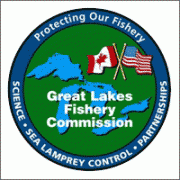Great Lakes Fishery Commission Commends Army Corps for Completion of Major Study to Stop Invasive Species
The Great Lakes Fishery Commission today commended the U.S. Army Corps of Engineers for completing the “Great Lakes and Mississippi River Interbasin Study,” (GLMRIS) a major report aimed at finding ways to prevent the movement of harmful invasive species between the Great Lakes and Mississippi River basins. The study, mandated by Congress, outlines a range of options available to re-separate the two basins, which were connected artificially more than one hundred years ago. The options presented, while protecting the entire Great Lakes basin from species like Asian carps and snakehead, also benefit the people of the Chicago region through better flood management and improved water quality. The report did not provide an exact plan (called a “preferred option”) for implementation, prompting the commission to join with scores of interested organizations and policy-makers to call for an immediate effort to agree upon and fund a specific project to achieve separation.
“The Great Lakes fishery is worth more than $7 billion annually to the people of Canada and the United States” said Great Lakes Fishery Commission Chairman Dr. Michael Hansen. “We know all too well the destructive power of invasive species like sea lamprey, zebra mussel, and round goby. Invasive species do not belong in our lakes; they inflict billions of dollars in damage to the economy and cause permanent damage to the environment. The GLMRIS report highlights the fact that the manmade waterway in the Chicago region is a two-way street, allowing the movement of harmful species between the Great Lakes and Mississippi River basins. Any action taken in Chicago protects the waters of the entire United States and Canada.”
“The GLMRIS report released today tells us that several viable options are available to achieve separation of the Great Lakes and Mississippi River basins,” Hansen continued. “The Great Lakes Fishery Commission has long argued that separation is the only way to ensure that injurious invasive species do not migrate between the two basins. Collectively, we have a duty to prevent an irreversible economic and environmental catastrophe and we must be sure we move faster than Asian carps.”
Hansen continued: “The GLMRIS report is the last major, outstanding product needed prior to the development of a specific plan to re-separate. GLMRIS, coupled with another report entitled ‘Restoring the Natural Divide,’ offer innovative ideas that can be incorporated into a separation project.”
Hansen concluded: “Asian carps and other invasive species are not going to wait for us to act, and major flood events seem to be occurring more regularly. We need to work right away with Congress, governments at all levels, the Metropolitan Water Reclamation District of Chicago, and stakeholders to develop and implement a separation project.”
The Chicago Area Waterway System (CAWS) was established in the late 1800s to address serious water quality issues caused by human waste and industries, such as meat packing. The natural course of the Chicago River hugged the shoreline near Chicago and discharged into Lake Michigan, the source of the city’s drinking water. A subcontinental divide kept Chicago’s wastewater in Chicago. Engineers breached the subcontinental divide to divert the Chicago River into the Mississippi River basin, thus creating the CAWS and preventing Chicago’s waste from contaminating drinking water. The CAWS later became a transportation vector, accommodating barge and other boat traffic.
Subsequent to construction of the CAWS, major water quality infrastructure was installed to further address Chicago’s wastewater problems. Today, the CAWS also serves as a flood control mechanism for the region and as a corridor for barge traffic. However, the CAWS has also become a two-way street for invasive species to spread and harm the Great Lakes and Mississippi River systems.
Asian carps, which escaped from southern aquaculture facilities in the 1970s, threaten to invade the Great Lakes via the CAWS. A recent assessment of the risk they pose, produced jointly by American and Canadian scientists, notes that Asian carps have the potential to wreak havoc on the Great Lakes’ economy and ecosystem. The GLMRIS report also notes that many other species threaten the two basins.
Recognizing the major threat of invasive species, and motivated to prevent the migration of Asian carps into the Great Lakes, many concerned citizens, government agencies, non-governmental organizations, and the Great Lakes Fishery Commission called for re-separating the two once-distinct ecosystems. The call for re-separation emerged from a 2003 Chicago report issued by then-mayor Richard Daley that recommended separation. In 2008, the Alliance for the Great Lakes (an environmental organization) produced a report that took the first look at the feasibility of separation. In early 2012, the Great Lakes Commission (an interstate agency addressing issues of importance to Great Lakes states and provinces) and the Great Lakes and Saint Lawrence Cities Initiative (a consortium of the basin’s mayors) produced a report entitled “Restoring the Natural Divide,” which highlighted specific options to achieve separation. The GLMRIS report released today was initiated in 2009 (and expedited starting in 2012); Congress directed the Army Corps through GLMRIS to present a range of options to prevent the movement of species between the two basins. View the Official Press Release.


